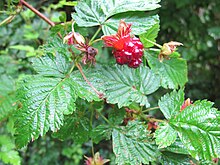Rubus spectabilis
| Salmonberry | |
|---|---|

| |

| |
| Scientific classification | |
| Kingdom: | Plantae |
| Clade: | Tracheophytes |
| Clade: | Angiosperms |
| Clade: | Eudicots |
| Clade: | Rosids |
| Order: | Rosales |
| Family: | Rosaceae |
| Genus: | Rubus |
| Species: | R. spectabilis
|
| Binomial name | |
| Rubus spectabilis | |
| Synonyms[1] | |
| |
Rubus spectabilis, the salmonberry, is a species of bramble in the rose family Rosaceae, native to the west coast of North America from west central Alaska to California, inland as far as Idaho.[2][3][4]
Description[]
Rubus spectabilis is a shrub growing to 1–4 m (3–13 ft) tall, with perennial (not biennial) woody stems that are covered with fine prickles. The leaves are trifoliate (with three leaflets), 7–22 cm (3–8+1⁄2 in) long, the terminal leaflet larger than the two side leaflets. The leaf margins are toothed. The flowers are 2–3 cm (3⁄4–1+1⁄4 in) in diameter, with five pinkish-purple petals; they are produced from early spring to early summer. The berries ripen from early May to late July in most of the Pacific Northwest (later in cooler climates), and resemble large shiny yellow to orange-red blackberries 1.5–2 cm (1⁄2–3⁄4 in) long with many drupelets.[5][6] These are eaten by many birds and other animals.[7]
Salmonberries are found in moist forests and stream margins, especially in the coastal areas. In open areas they often form large thickets, and thrive in the open spaces under stands of red alder (Alnus rubra).
A similar species from Japan, the red-flowered raspberry (ベニバナイチゴ) was once considered its subspecies as R. spectabilis subsp. vernus. It is now reclassified as Rubus vernus.[8]
Cultivation and uses[]
Salmonberries are edible and share the fruit structure of the raspberry, with the fruit pulling away from its receptacle.[9][10] The fruit has been referred to as "insipid",[11] but depending on ripeness and site, they are good eaten raw – whether red or golden[9] – and when processed into jam, candy, jelly and wine. Native American people and early explorers also ate the young shoots.[12] Traditionally, the berries were eaten with salmon or mixed with oolichan grease or salmon roe. They were not dried because of their high moisture content.[11]
It is widely grown as an ornamental plant for its flowers,[9][13][14] with a double-flowered clone identified in Washington and British Columbia.[15] R. spectabilis has escaped cultivation and become naturalized in parts of northwestern Europe, including Great Britain, Ireland and the Faroe Islands.[16][17]

Each flower has 75 to 100 stamens
Foliage
Mature fruit in Mount Baker-Snoqualmie National Forest

Colander of salmonberries

Salmonberry fruit in Unalaska (Dutch Harbor), Alaska
References[]
- ^ Jump up to: a b "Rubus spectabilis Mercier — The Plant List". www.theplantlist.org.
- ^ "Biota of North America Program 2014 state-level distribution map".
- ^ "Biota of North America Program 2014 county distribution map".
- ^ Calflora taxon report, University of California, Rubus spectabilis Pursh, salmon berry, salmonberry
- ^ "Plants of British Columbia: Rubus spectabilis". Linnet.geog.ubc.ca. Retrieved December 9, 2014.
- ^ "Jepson Flora: Rubus spectabilis". Ucjeps.berkeley.edu. Retrieved December 9, 2014.
- ^ Whitney, Stephen (1985). Western Forests (The Audubon Society Nature Guides). New York: Knopf. p. 419. ISBN 978-0-394-73127-8.
- ^ Naruhashi, Naruhito (June 15, 1980). "Rubus vernus FOCKE and R. spectabilis PURSH". The Journal of Phytogeography and Taxonomy (The Journal of Geobotany). 28: 13 – via ISSN 0388-6212.
- ^ Jump up to: a b c Mosquin, Daniel (23 May 2015). "Rubus spectabilis". University of British Columbia Botanical Garden. Retrieved 12 April 2021.
- ^ Fagan, Damian (2019). Wildflowers of Oregon: A Field Guide to Over 400 Wildflowers, Trees, and Shrubs of the Coast, Cascades, and High Desert. Guilford, CT: FalconGuides. p. 222. ISBN 978-1-4930-3633-2. OCLC 1073035766.
- ^ Jump up to: a b Pojar, Jim; Andy MacKinnon (2004). Plants Of The Pacific Northwest Coast: Washington, Oregon, British Columbia & Alaska. Lone Pine Publishing. p. 76. ISBN 978-1-55105-530-5.
- ^ Lyons, C. P. (1956). Trees, Shrubs and Flowers to Know in Washington (1st ed.). Canada: J. M. Dent & Sons. p. 88.
- ^ Mulligan, Brian O. (1977). Woody Plants in the University of Washington Arboretum, Washington Park. University of Washington, College of Forest Resources, Seattle.
- ^ Mulligan, Brian O. (1963). Accession records of the University of Washington Arboretum
- ^ Mosquin, Daniel (23 April 2007). "Rubus spectabilis Double-Flowered Group". University of British Columbia Botanical Garden. Retrieved 12 April 2021.
- ^ Inland Fisheries Ireland. "Risk Assessment of Rubus spectabilis" (PDF). nonnativespecies.ie. National Biodiversity Data Centre. Retrieved May 1, 2018.
- ^ Højgaard, A. et al., eds. (1989). A century of tree-planting in the Faroe Islands. Føroya Fróðskaparfelag, Tórshavn.
External links[]
| Wikimedia Commons has media related to Rubus spectabilis. |
- Czech Botany, Rubus spectabilis Pursh – ostružiník / ostružina in Czech with color photos of flowers, fruits, and leaves
- Plants for a Future
- US National Forest Service, Index of Species Information
- University of Washington plant data sheet
- "Rubus spectabilis". Natural Resources Conservation Service PLANTS Database. USDA. Retrieved 2009-06-30.
- Rubus
- Berries
- Edible fruits
- Flora of the Western United States
- Flora of British Columbia
- Flora of Alaska
- Garden plants of North America
- Plants described in 1813




